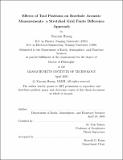Effects of Tool Positions on Borehole Acoustic Measurements: a Stretched Grid Finite Difference Approach
Author(s)
Huang, Xiaojun
DownloadXHTHESIS.pdf (42.01Mb)
Other Contributors
Massachusetts Institute of Technology. Earth Resources Laboratory
Metadata
Show full item recordAbstract
This dissertation made three contributions to numerical simulation and borehole
acoustic logging.
The first one is a novel finite difference time domain algorithm that features non-
uniform grid, wavelet-based difference operator and anisotropic perfectly matched
layer. This algorithm reduces numerical reflections and wave distortions introduced
by grid change to a minimum by sampling the physical space with gradually varying
mesh. By coordinate stretching, the algorithm discretizes the physical space with variable grid, while solving the wave equation on a uniform mesh. That approach helps
retain the advantages pertaining to uniform mesh. Further improvement in efficiency
is achieved without losing accuracy by the development of a wavelet-based difference
operator. By using a family of compactly supported wavelet function, the wavelet-
based finite difference time domain algorithm allows less grid point per wavelength.
Coordinate stretching is also employed in deriving an anisotropic perfectly matched
layer, superior to currently available perfectly matched layer formulation which requires field splitting, a process that results in more computer memory requirement for
the storage of extra variables. Validations of the algorithm include comparison with
analytical solutions, uniform grid FDTD solutions and discrete wavenumber results.
The second contribution is a time domain investigation of wave propagations in
the logging while drilling situation. Logging while drilling is an emerging downhole
acoustic acquisition method. The investigation is focused on soft formations where
formation shear velocity is slower than borehole fluid velocity, because shear velocity
measurement, one of the key measurements that acoustic logging is designed to acquire, is the most problematic in soft formations. Special attention is paid to mode
excitations, with respect to frequencies, tool positions and source types, in the hope
to shed some light on some highly debated questions regarding tool design and data
interpretation. The stretched grid finite difference algorithm is applied.
The third contribution is the development of an inversion method to estimate
stress magnitudes and directions from borehole acoustic measurements. It is predicted
in theory that a crossover in flexural dispersion is an indicator of stress-induced
anisotropy dominating over other sources of intrinsic anisotropy. The prediction is
subsequently verified in a scaled-borehole experiment. We are the first ones that
observe flexural dispersion crossover in field data. Using the flexural crossover as a
stress signature on the borehole acoustic data, we are able to isolate stressed zones.
The maximum horizontal stress direction coincides with the polarization direction of
far field fast shear. The stress magnitude is related to velocity changes in the stressed
state from the zero stress or hydrostatically balanced state, through a perturbation
theory developed in the late 1990's. Stress directions estimated in this dissertation
are consistent with focal mechanism and borehole breakout data present in the world
stress map database.
Date issued
2003Publisher
Massachusetts Institute of Technology. Earth Resources Laboratory
Series/Report no.
Earth Resources Laboratory Industry Consortia Annual Report;2003-13